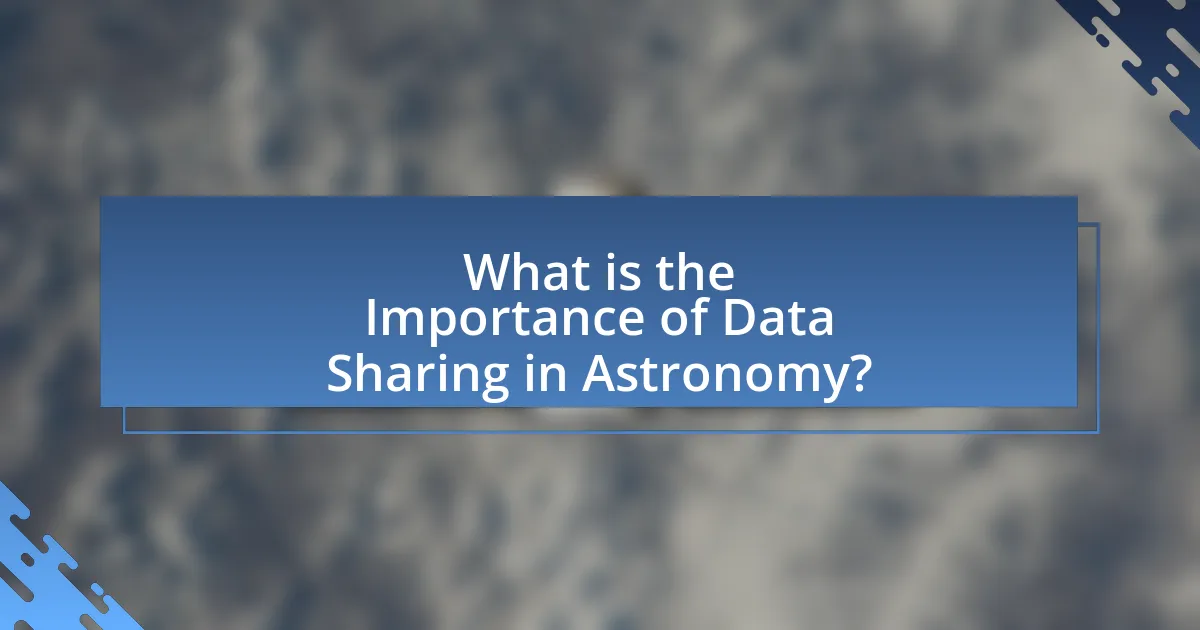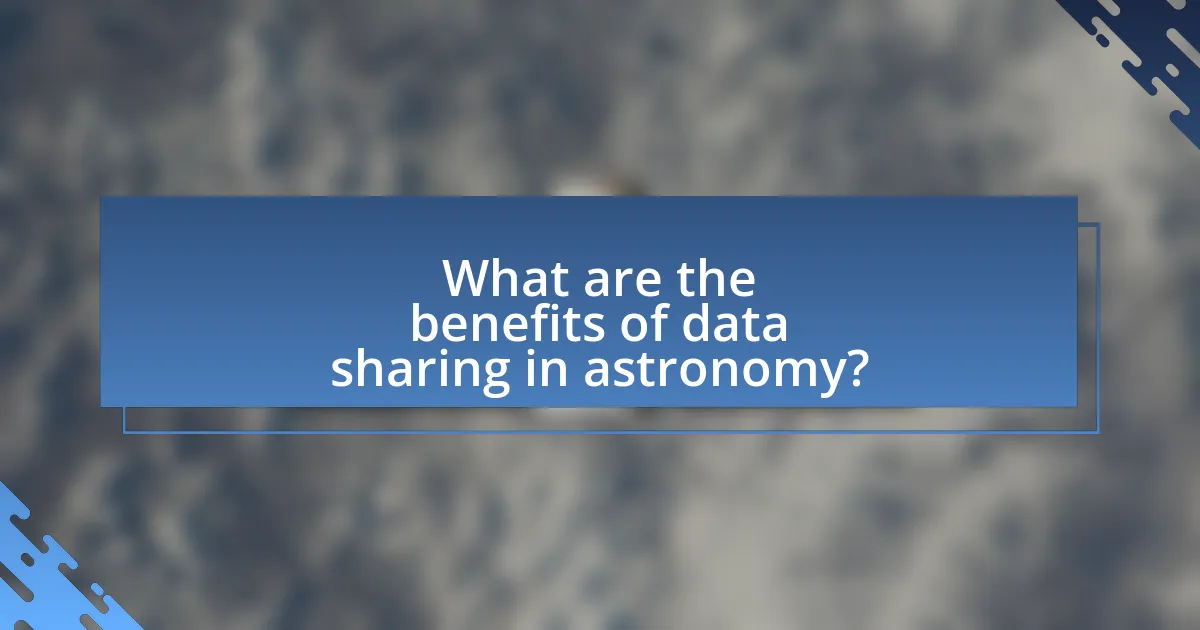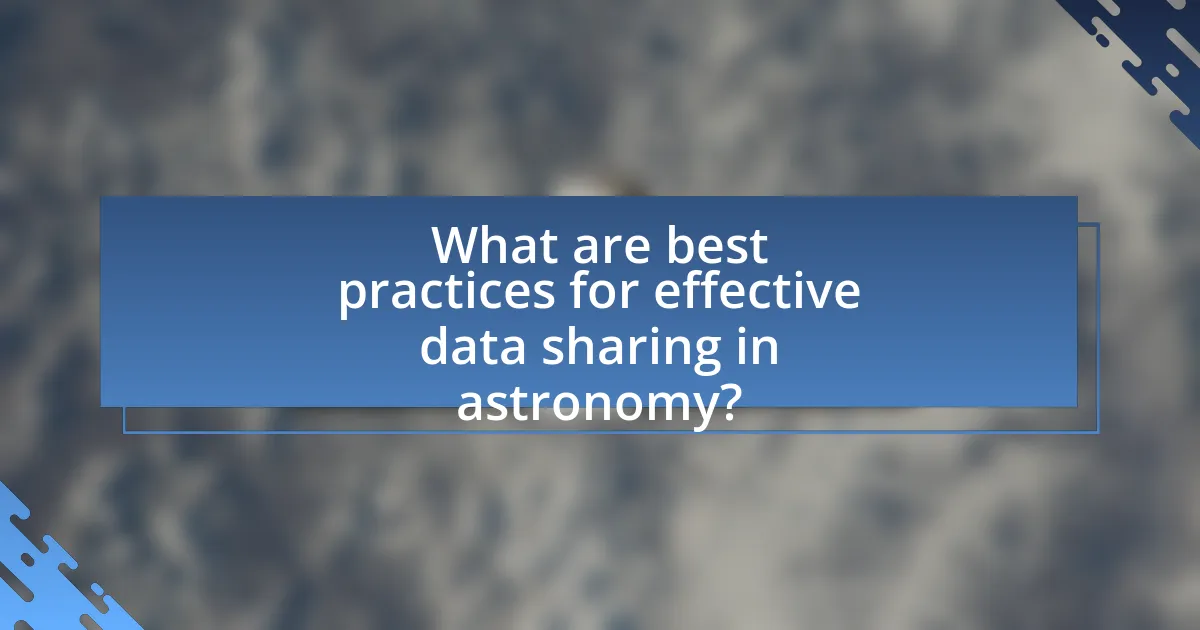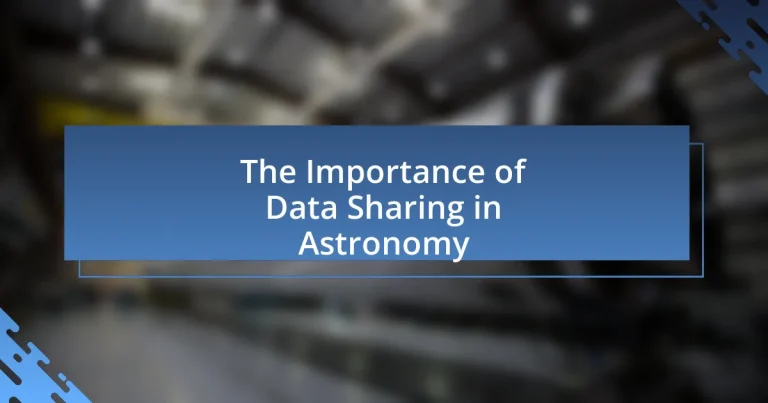Data sharing in astronomy is essential for enhancing scientific collaboration and advancing research. It allows astronomers to access extensive datasets, leading to significant discoveries and improved understanding of celestial phenomena. The article explores the importance of data sharing, the types of data commonly shared, the challenges faced in the astronomy community, and best practices for effective data sharing. It also highlights the role of collaboration, technological advancements, and emerging initiatives that promote open access to astronomical data, ultimately fostering innovation and public engagement in the field.

What is the Importance of Data Sharing in Astronomy?
Data sharing in astronomy is crucial for advancing scientific knowledge and collaboration among researchers. It enables astronomers to access and analyze vast datasets, facilitating discoveries that would be impossible for individual researchers working in isolation. For instance, the Sloan Digital Sky Survey has provided a comprehensive catalog of celestial objects, which has been utilized by thousands of scientists worldwide to enhance our understanding of the universe. Furthermore, data sharing fosters transparency and reproducibility in research, allowing independent verification of results and promoting trust within the scientific community.
Why is data sharing crucial for astronomical research?
Data sharing is crucial for astronomical research because it enhances collaboration, accelerates discoveries, and allows for comprehensive analysis of celestial phenomena. By sharing data, astronomers can combine observations from different telescopes and instruments, leading to a more complete understanding of the universe. For instance, the Sloan Digital Sky Survey has made its data publicly available, enabling thousands of researchers to contribute to significant findings, such as the discovery of new galaxies and insights into dark matter. This collaborative approach not only fosters innovation but also ensures that research is reproducible and verifiable, which is essential for scientific integrity.
What role does collaboration play in data sharing among astronomers?
Collaboration is essential in data sharing among astronomers as it enhances the collective understanding of astronomical phenomena. By working together, astronomers can pool resources, share diverse datasets, and leverage different expertise, which leads to more comprehensive analyses and discoveries. For instance, large-scale projects like the Sloan Digital Sky Survey involve collaboration among multiple institutions, resulting in a vast database that has significantly advanced research in various fields of astronomy. This collaborative approach not only accelerates the pace of scientific discovery but also fosters innovation through the integration of different perspectives and methodologies.
How does data sharing enhance the quality of astronomical findings?
Data sharing enhances the quality of astronomical findings by facilitating collaborative research and enabling the cross-validation of results. When astronomers share data, they allow multiple teams to analyze the same datasets, which increases the reliability of findings through independent verification. For instance, the Sloan Digital Sky Survey has provided a wealth of publicly available data that has led to numerous discoveries by different research groups, demonstrating how shared resources can lead to a more comprehensive understanding of celestial phenomena. Additionally, data sharing promotes the use of advanced analytical techniques and tools across the scientific community, further improving the accuracy and depth of astronomical research.
What types of data are commonly shared in astronomy?
Commonly shared data in astronomy includes observational data, which encompasses images and spectra from telescopes, as well as catalog data that lists celestial objects and their properties. Additionally, simulation data, which involves models of cosmic phenomena, and theoretical data, which includes predictions and calculations related to astrophysics, are also frequently shared. The sharing of such data facilitates collaboration among astronomers and enhances the understanding of the universe, as evidenced by large-scale projects like the Sloan Digital Sky Survey, which has made extensive astronomical data publicly available for research and analysis.
What are the main categories of astronomical data?
The main categories of astronomical data are observational data, theoretical data, and archival data. Observational data includes measurements obtained from telescopes and instruments, such as images, spectra, and time-series data. Theoretical data encompasses simulations and models that predict astronomical phenomena, often based on physical laws. Archival data consists of previously collected data stored for future analysis, which can include historical observations and datasets from past missions. These categories are essential for advancing our understanding of the universe and facilitating collaboration among astronomers.
How do different types of data contribute to various research fields?
Different types of data significantly contribute to various research fields by providing unique insights and facilitating advancements in knowledge. In astronomy, for instance, observational data from telescopes, such as light curves and spectral data, enable researchers to study celestial phenomena, leading to discoveries like exoplanets and the expansion of the universe. Additionally, simulation data helps in modeling cosmic events, while archival data allows for historical comparisons and trend analysis. The combination of these data types enhances the understanding of complex astronomical concepts, as evidenced by the discovery of gravitational waves, which relied on both observational and theoretical data to validate the existence of black hole mergers.
What challenges exist in data sharing within the astronomy community?
Data sharing within the astronomy community faces several challenges, including data standardization, access rights, and varying levels of technological infrastructure. Data standardization issues arise because different observatories and research institutions often use diverse formats and protocols, making it difficult to integrate and analyze data collectively. Access rights pose a challenge as researchers may have proprietary claims over their data, leading to reluctance in sharing. Additionally, varying levels of technological infrastructure among institutions can hinder the ability to share and process large datasets effectively. These challenges can impede collaborative research efforts and slow down scientific progress in the field of astronomy.
What are the technical barriers to effective data sharing?
The technical barriers to effective data sharing include data format incompatibility, insufficient data interoperability, and inadequate infrastructure for data storage and transmission. Data format incompatibility arises when different systems use varying formats, making it difficult to exchange information seamlessly. Insufficient data interoperability occurs when systems cannot communicate or integrate due to differing standards or protocols, hindering collaborative efforts. Inadequate infrastructure for data storage and transmission can lead to bottlenecks, limiting the ability to share large datasets efficiently. These barriers are critical in astronomy, where diverse datasets from multiple observatories and instruments must be integrated for comprehensive analysis.
How do privacy and ownership issues affect data sharing?
Privacy and ownership issues significantly hinder data sharing by creating barriers to access and collaboration. When individuals or organizations feel that their data is not secure or that they do not retain ownership rights, they are less likely to share that data. For instance, the General Data Protection Regulation (GDPR) in Europe imposes strict guidelines on personal data usage, which can limit the sharing of astronomical data that may inadvertently include personal information. Additionally, ownership disputes can arise when multiple parties contribute to a dataset, leading to reluctance in sharing due to fears of losing control over the data. These factors collectively reduce the volume and quality of data available for research and collaboration in astronomy, ultimately impeding scientific progress.
How can data sharing practices be improved in astronomy?
Data sharing practices in astronomy can be improved by implementing standardized data formats and protocols. Standardization facilitates interoperability among different observatories and research institutions, allowing for seamless data exchange. For instance, the Virtual Observatory initiative promotes the use of common data formats and services, which enhances collaboration and data accessibility. Additionally, establishing clear data sharing policies and incentivizing open data practices among researchers can further enhance the availability and usability of astronomical data. Studies show that open data initiatives lead to increased citations and collaborative research, demonstrating the benefits of improved data sharing practices in the field.
What technologies facilitate better data sharing among astronomers?
Cloud computing platforms facilitate better data sharing among astronomers by providing scalable storage and processing capabilities. These platforms, such as Amazon Web Services and Google Cloud, enable astronomers to store vast amounts of data generated by telescopes and simulations, allowing for easy access and collaboration across institutions. Additionally, data sharing protocols like the Virtual Observatory (VO) standards promote interoperability among different astronomical databases, ensuring that data can be easily queried and integrated. The use of application programming interfaces (APIs) further enhances this by allowing seamless data exchange between software tools and databases. These technologies collectively improve collaboration and efficiency in astronomical research, as evidenced by projects like the Sloan Digital Sky Survey, which utilizes cloud infrastructure to manage and share extensive datasets with the global astronomical community.
How can policies and guidelines enhance data sharing efforts?
Policies and guidelines enhance data sharing efforts by establishing clear frameworks that promote collaboration and standardization among researchers. These frameworks facilitate the consistent use of data formats and protocols, which reduces barriers to access and encourages interoperability between different data systems. For instance, the implementation of the FAIR principles (Findable, Accessible, Interoperable, and Reusable) in data management policies has been shown to improve data sharing in scientific communities, including astronomy, by ensuring that datasets are well-documented and easily discoverable. Furthermore, guidelines that mandate data sharing as part of grant funding requirements have led to increased compliance and transparency, ultimately fostering a culture of openness and collaboration in research.

What are the benefits of data sharing in astronomy?
Data sharing in astronomy enhances collaboration, accelerates discoveries, and improves data quality. By allowing researchers to access and analyze shared datasets, astronomers can validate findings, build upon each other’s work, and foster innovation. For instance, the Sloan Digital Sky Survey has provided a wealth of publicly available data, leading to significant advancements in our understanding of the universe, including the discovery of new celestial objects and insights into cosmic evolution. This collaborative approach not only maximizes the use of resources but also democratizes access to astronomical data, enabling contributions from a diverse range of scientists worldwide.
How does data sharing accelerate scientific discovery?
Data sharing accelerates scientific discovery by enabling researchers to access and utilize a broader range of data, fostering collaboration and innovation. When scientists share their findings and datasets, they allow others to validate results, replicate studies, and build upon existing knowledge, which is crucial in fields like astronomy where data can be scarce and complex. For instance, the Sloan Digital Sky Survey has made extensive astronomical data publicly available, leading to thousands of scientific papers and discoveries, demonstrating that open access to data significantly enhances the pace of research and discovery in the field.
What examples illustrate the impact of shared data on major discoveries?
Shared data has significantly impacted major discoveries in astronomy, exemplified by the discovery of the Higgs boson and the identification of exoplanets. The Higgs boson was confirmed through data sharing among CERN’s Large Hadron Collider collaborations, where over 3000 scientists analyzed vast datasets collectively, leading to the particle’s discovery in 2012. Similarly, the Kepler Space Telescope’s mission relied on shared data from multiple observatories, enabling the identification of thousands of exoplanets, which has transformed our understanding of planetary systems. These examples demonstrate that collaborative data sharing accelerates scientific breakthroughs and enhances the depth of astronomical research.
How does data sharing foster innovation in astronomical techniques?
Data sharing fosters innovation in astronomical techniques by enabling collaborative research and access to diverse datasets, which accelerates the development of new methodologies. When astronomers share data, they allow others to apply different analytical techniques, leading to novel insights and discoveries. For instance, the Sloan Digital Sky Survey has provided a wealth of data that has been utilized by thousands of researchers, resulting in advancements in galaxy classification and dark matter studies. This collaborative approach not only enhances the quality of research but also promotes the cross-pollination of ideas, ultimately driving technological advancements in observational and computational techniques in astronomy.
What role does data sharing play in public engagement with astronomy?
Data sharing plays a crucial role in enhancing public engagement with astronomy by making astronomical data accessible to a wider audience. When data from telescopes and space missions are shared openly, it allows amateur astronomers, educators, and the general public to participate in scientific discovery, fostering a sense of community and collaboration. For instance, projects like Galaxy Zoo enable volunteers to classify galaxies using shared data, directly involving them in research efforts. This participatory approach not only increases public interest in astronomy but also educates individuals about scientific processes and the universe, as evidenced by the significant increase in citizen science projects that rely on shared astronomical data.
How can shared data enhance educational opportunities in astronomy?
Shared data enhances educational opportunities in astronomy by providing access to a wealth of information that can be utilized for research, analysis, and learning. This accessibility allows students and educators to engage with real astronomical data, fostering hands-on experience and critical thinking skills. For instance, initiatives like the Sloan Digital Sky Survey have made extensive datasets available, enabling learners to conduct their own investigations and draw conclusions based on actual observations. Furthermore, collaborative platforms such as the International Virtual Observatory promote data sharing among institutions, enhancing the scope of educational resources and encouraging a global exchange of knowledge. This collective approach not only enriches the learning experience but also prepares students for future careers in science and technology by equipping them with practical skills in data analysis and interpretation.
What initiatives promote public access to astronomical data?
Initiatives that promote public access to astronomical data include the Virtual Observatory (VO), NASA’s data archives, and the European Space Agency’s (ESA) data services. The Virtual Observatory provides a framework for accessing and analyzing astronomical data from multiple sources, enabling researchers and the public to utilize vast datasets. NASA’s data archives, such as the Hubble Space Telescope Archive, offer free access to images and data collected from space missions, fostering public engagement and research opportunities. The ESA’s data services, including the Gaia mission data, allow users to access detailed astronomical information, supporting both scientific research and educational purposes. These initiatives collectively enhance transparency and collaboration in the field of astronomy.

What are best practices for effective data sharing in astronomy?
Best practices for effective data sharing in astronomy include establishing standardized data formats, ensuring comprehensive metadata documentation, and utilizing open-access repositories. Standardized data formats, such as FITS (Flexible Image Transport System), facilitate interoperability among different astronomical datasets, allowing researchers to easily share and analyze data. Comprehensive metadata documentation is crucial as it provides context, ensuring that users understand the data’s origin, structure, and intended use. Utilizing open-access repositories, like the NASA/IPAC Infrared Science Archive, promotes wider accessibility and encourages collaboration among astronomers, enhancing the overall scientific community’s ability to leverage shared data for research and discovery.
How can astronomers ensure data quality and integrity when sharing?
Astronomers can ensure data quality and integrity when sharing by implementing standardized data formats and rigorous validation processes. Standardized formats, such as FITS (Flexible Image Transport System), facilitate consistent data representation, making it easier to share and analyze across different platforms. Rigorous validation processes, including automated checks for data completeness and accuracy, help identify errors before data is shared. Research indicates that adherence to these practices significantly reduces discrepancies and enhances the reliability of shared astronomical data, as evidenced by the successful implementation of these standards in major astronomical surveys like the Sloan Digital Sky Survey.
What standards should be followed for data documentation and metadata?
Data documentation and metadata should adhere to established standards such as the Data Documentation Initiative (DDI), the Dublin Core Metadata Initiative (DCMI), and the International Organization for Standardization (ISO) 19115 for geographic information. These standards provide structured frameworks for describing data, ensuring consistency, interoperability, and accessibility. For instance, DDI facilitates the documentation of social science data, while Dublin Core offers a simple yet effective metadata schema applicable across various domains. ISO 19115 specifically addresses geographic information, promoting effective data sharing and discovery. Following these standards enhances the usability and reusability of data, which is crucial in fields like astronomy where collaboration and data sharing are essential for advancing research.
How can data sharing platforms be optimized for user accessibility?
Data sharing platforms can be optimized for user accessibility by implementing user-friendly interfaces, ensuring compatibility with assistive technologies, and providing comprehensive user support. User-friendly interfaces enhance navigation and usability, which is crucial for diverse user groups, including those with disabilities. Compatibility with assistive technologies, such as screen readers and voice recognition software, ensures that all users can access and utilize the platform effectively. Comprehensive user support, including tutorials and responsive help desks, further aids users in overcoming barriers to access. Research indicates that platforms designed with accessibility in mind can increase user engagement and satisfaction, thereby promoting more effective data sharing in fields like astronomy.
What strategies can researchers adopt to promote data sharing?
Researchers can promote data sharing by implementing open access policies, utilizing data repositories, and fostering collaboration through interdisciplinary networks. Open access policies encourage researchers to publish their data in publicly accessible formats, which increases visibility and usability. Utilizing established data repositories, such as the NASA/IPAC Infrared Science Archive, ensures that data is stored in a secure and organized manner, making it easier for others to access and use. Additionally, fostering collaboration through interdisciplinary networks, like the International Astronomical Union, facilitates the exchange of data and best practices among researchers, enhancing the overall quality and impact of astronomical research. These strategies are supported by studies showing that open data practices lead to increased citations and collaborative opportunities in scientific fields.
How can collaboration networks be established among astronomers?
Collaboration networks among astronomers can be established through the creation of shared platforms for data exchange and communication. These platforms facilitate the pooling of resources, expertise, and observational data, enabling astronomers to work together on research projects. For instance, initiatives like the Virtual Observatory and the Astrophysics Data System provide centralized access to astronomical data, fostering collaboration across institutions and countries. Studies have shown that collaborative research leads to increased publication rates and more impactful findings, as evidenced by the rise in co-authored papers in astronomy journals over the past two decades.
What incentives can encourage data sharing in the astronomy community?
Incentives that can encourage data sharing in the astronomy community include recognition through authorship credit, funding opportunities for collaborative projects, and access to exclusive resources or datasets. Recognition through authorship credit motivates researchers to share data as it enhances their academic reputation and visibility. Funding opportunities for collaborative projects incentivize data sharing by providing financial support for joint research efforts, which can lead to more comprehensive studies. Access to exclusive resources or datasets encourages sharing by allowing researchers to utilize shared data for their own projects, thereby increasing the overall value of the shared information. These incentives are supported by studies indicating that collaborative research leads to higher citation rates and increased innovation in scientific fields.
What are the future trends in data sharing for astronomy?
Future trends in data sharing for astronomy include increased collaboration through open data initiatives, enhanced use of cloud computing for data storage and processing, and the implementation of advanced machine learning algorithms for data analysis. Open data initiatives, such as the European Space Agency’s commitment to making satellite data publicly available, promote transparency and accessibility, allowing researchers worldwide to contribute to astronomical discoveries. Cloud computing facilitates the handling of vast datasets generated by telescopes and observatories, enabling real-time data sharing and collaborative research. Additionally, machine learning techniques are increasingly employed to analyze large datasets, improving the efficiency and accuracy of astronomical research. These trends reflect a shift towards a more interconnected and data-driven approach in the field of astronomy.
How might advancements in technology shape data sharing practices?
Advancements in technology will significantly shape data sharing practices by enhancing the speed, security, and accessibility of astronomical data. For instance, the development of cloud computing allows researchers to store and share vast amounts of data efficiently, facilitating real-time collaboration across global institutions. Additionally, the implementation of blockchain technology can improve data integrity and security, ensuring that shared data remains unaltered and trustworthy. Furthermore, machine learning algorithms can automate data processing, enabling quicker analysis and dissemination of findings. These technological improvements are crucial as they support the growing volume of data generated by telescopes and satellites, which, according to the European Space Agency, is expected to increase exponentially in the coming years.
What emerging collaborations could redefine data sharing in astronomy?
Emerging collaborations that could redefine data sharing in astronomy include partnerships between large observatories, space agencies, and technology companies. For instance, the collaboration between NASA and the European Space Agency on the James Webb Space Telescope aims to create a unified data archive accessible to researchers worldwide. This initiative enhances data sharing by providing standardized formats and tools for analysis, facilitating global collaboration. Additionally, initiatives like the Virtual Observatory project promote interoperability among different astronomical databases, allowing seamless access to diverse datasets. These collaborations are crucial as they enable researchers to leverage vast amounts of data, leading to more comprehensive studies and discoveries in the field of astronomy.


